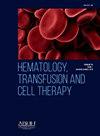评价银复合物与柠檬烯在鳞状细胞癌和黑色素瘤细胞系中的潜在治疗关联的抗增殖作用
IF 1.8
Q3 HEMATOLOGY
引用次数: 0
摘要
导言/理由皮肤癌与紫外线照射密切相关,是全球最常见的恶性肿瘤,包括鳞状细胞癌(SCC)和皮肤黑色素瘤(CM)。尽管顺铂和 5-FU 是治疗鳞状细胞癌和皮肤黑色素瘤的标准疗法,但开发新的替代疗法至关重要。银络合物显示出了良好的抗癌潜力,而单萜烯柠檬烯则显示出了增强皮肤渗透性的功效,支持其在局部给药中的应用。材料与方法坎皮纳斯大学化学研究所合成了银络合物 I 和 II。纯物质 R-(+)-limonene 和 S-(-)-limonene 购自默克公司。咽部 SCC(FaDU)和黑色素瘤(A-375、SK-MEL-28)细胞(4 × 10³ cells/mL)用复合物 I e II(0.4-400 µM)或它们与 R-(+) 和 S-(-) 柠檬烯的复合物(4 µM)处理。顺铂和 5-FU(100 μL/孔,0.4 至 400 µg/mL,一式三份)用作阳性对照。在加入样品前(T0)和加入样品后(T1),用 50%三氯乙酸(TCA,50 μL/孔)固定细胞,然后重悬于 Tris 碱中,随后用微孔板阅读器分光光度计(VersaMax,Molecular Devices)在 540 纳米波长下测定吸光度。T0 和 T1 吸光度值之间的差值代表 100% 的细胞生长。使用 Origin 8.0 软件通过西格玛回归法计算出有效浓度(IC50),该浓度代表促进每个细胞系 50%生长抑制所需的样品浓度。组合还原指数(CRI)的计算方法为:金属复合物 + 单萜的 IC50 / 单金属复合物的 IC50。在 SCC 和 CM 细胞系中,银络合物 I 的抗增殖作用介于 4 µM 到 10 µM 之间,而银络合物 II 在相同细胞系中的抗增殖作用介于 1 µM 到 6 µM 之间。银络合物 I 与 S-(-)-limonene 结合使用会在 FaDu 细胞系中产生协同效应,IC50 < 2 µM,CRI = 0.4。银复合物 II 与两种对映体的结合在 FaDu 和 SK-MEL-28 细胞中显示出部分协同效应,IC50 <1.5 µM,CRI = 0.5。有必要进行更多实验来评估其作用机制和毒性。本研究得到了圣保罗州教育与科研基金会(CAPES)和癌症治疗创新中心(CancerThera)的支持(FAPESP #2016/07729-4;#2023/09738-4;CEPID FAPESP #2021/10265-8)。本文章由计算机程序翻译,如有差异,请以英文原文为准。
EVALUATION OF ANTIPROLIFERATIVE OF A POTENTIAL THERAPEUTIC ASSOCIATION OF SILVER COMPLEXES WITH LIMONENE IN SQUAMOUS CELL CARCINOMA AND MELANOMA CELL LINES
Introduction/Justification
Skin cancer, strongly associated with UV exposure, is the most common malignancy worldwide, including squamous cell carcinoma (SCC), and cutaneous melanoma (CM). Although cisplatin and 5-FU are standard treatments for SCC and CM, the development of new therapeutic alternatives is crucial. Silver complexes have shown promising anticancer potential, while the monoterpene limonene has demonstrated efficacy in enhancing skin permeation, supporting its application in topical drug delivery.
Objectives
Our study aimed to evaluate the in vitro antiproliferative effects of silver complexes and limonene, isolated and in association.
Materials and Methods
The silver complexes identified as I and II were synthesized at the Institute of Chemistry of University of Campinas. The pure substances R-(+)-limonene and S-(-)-limonene were acquired from Merck. Pharyngeal SCC (FaDU) and melanoma (A-375, SK-MEL-28) cells (4 × 10³ cells/mL) were treated with complexes I e II (0.4–400 µM) or their combination with R-(+) and S-(-) limonene (4 µM). Cisplatin and 5-FU (100 μL/well, 0.4 to 400 µg/mL, in triplicate) were used as positive controls. Before (T0) and after (T1) sample addition, cells were fixed with 50% trichloroacetic acid (TCA, 50 μL/well), and were then resuspended in Tris base for subsequent absorbance at 540 nm with a microplate reader spectrophotometer (VersaMax, Molecular Devices). The difference between T0 and T1 absorbance values represented 100% cell growth. Effective concentration representing the sample concentration required to promote 50% growth inhibition (IC50) for each cell line was calculated by sigmoidal regression using Origin 8.0 software. The Combination Reduction Index (CRI) was calculated as IC 50 of the metal complex + monoterpene / IC 50 of the metal complex alone.
Results
Both silver complexes exhibited potent antiproliferative activity. The antiproliferative effect of silver complex I ranged from 4 µM to 10 µM in SCC and CM cell lines, whereas the antiproliferative effect of silver complex II ranged from 1 µM to 6 µM in the same cell lines. The association of silver complex I in combination with S-(-)-limonene resulted in synergism effect in the FaDu cell line with IC50 < 2 µM, CRI = 0.4. The association of silver complex II with both enantiomers demonstrated a partial synergistic effect in the FaDu and SK-MEL-28 cells, with IC50 <1.5 µM and CRI = 0.5.
Conclusion
Silver complexes are promising candidates for in vivo studies as potential alternatives for the treatment of patients with SCC and CM. Additional experiments are necessary to evaluate their mechanism of action and toxicity. The study was supported by Coordenação de Aperfeiçoamento de Pessoal de Nível Superior (CAPES), Fundação de Apoio ao Ensino e à Pesquisa do Estado de São Paulo (FAPESP #2016/07729-4; #2023/09738-4 and Cancer Theranostics Innovation Center, (CancerThera), CEPID FAPESP #2021/10265-8).
求助全文
通过发布文献求助,成功后即可免费获取论文全文。
去求助
来源期刊

Hematology, Transfusion and Cell Therapy
Multiple-
CiteScore
2.40
自引率
4.80%
发文量
1419
审稿时长
30 weeks
 求助内容:
求助内容: 应助结果提醒方式:
应助结果提醒方式:


